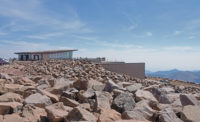High in the Never Summer Mountains of Colorado sits a critical piece of infrastructure for the city of Fort Collins Utilities Dept. known as the Michigan Ditch. The 5.2-mile-long ditch was originally constructed in the early 1900s to convey water from the west side of the mountain range to the east. The city purchased the ditch system 40 years ago and has maintained it ever since, placing a $150-million to $300-million value on the collected water it provides.
Although slope instability has plagued the ditch throughout its history, a previously piped section of the ditch through an area known as “the mudslide” moved 21 ft horizontally and 7 ft vertically during the 2014-15 winter. Since the majority of the collected water flows through the landslide area at 100 cu ft per second, the Michigan Ditch was going to be out of service for the foreseeable future and a permanent solution was needed.
Degree of Difficulty
Site logistics at 10,300 ft above sea level make for a challenging and short construction season. The city of Fort Collins used its alternative product delivery system (APDS) in a design-build, team-oriented approach to solve the problem. The program allows the city to quickly move forward on assembling a team.
Picking from a number of pre-qualified and pre-approved designers and contractors in July 2015, the city assembled a design-build team and began discussing options for permanent repairs to the ditch. Ultimately, the construction of a tunnel behind the landslide in competent rock was deemed the best long-term solution.
A thorough geotechnical investigation in late summer 2015 confirmed the tunnel alignment. Crews took eight vertical borings, along with three horizontal borings. The subsurface investigation showed a much-deeper section of the landslide than previously anticipated. Those findings, combined with the geometry of the site, meant that a curved tunnel alignment would work best to keep the ditch in solid bedrock.
Additional considerations on tunneling methods and carrier-pipe selection produced a final plan that called for a 765-ft-long, 8-ft-diameter tunnel built on a 630-ft radius curve. That allowed for installation of a 60-in.-diameter Hobas carrier pipe. An additional 200 ft of open-cut, 60-in. pipe would also be built to tie into the existing ditch.
Key Challenges
The first challenge was to pick a tunneling machine that the team could transport up to the jobsite. The project is located two miles up a single-track dirt road with a small launch and retrieval site on the side of a mountain, so getting a crane there to unload equipment was not an option.
The design-build team talked with multiple suppliers and decided on a custom-built tunnel boring machine (TBM) from Akkerman Inc. in Minnesota. The 96-in.-diameter Akkerman 720 Series II TBM was outfitted with a mixed-face cutterhead that uses 13 disc cutters, 40 scraper teeth and four scraper bars.
The cutterhead was built out to 98 in. to provide enough overcut to make the 630-ft radius curve.
Also, the TBM weighed less than 50,000 lbs, had a relatively small setup and retrieval footprint, and could be fabricated in the six-month timeframe needed to start construction. If the TBM could handle the geology of the tunnel drive, the construction team was relatively confident it could be delivered and retrieved from the site.
The second challenge was building the tunnel accurately and safely. A state-of-the-art guidance system from VMT Technical Measurement Solutions Inc., combined with routine survey checks by two different survey teams, provided the TBM operators and on-site construction inspectors with constant feedback on the position of the tunnel construction.
The tunnel was built within 0.01 in. horizontally and 1 in. vertically of the design. Building the job safely was a large task for the field supervisory team. Every work shift included a morning and afternoon safety briefing with an open discussion of the upcoming tasks and hazards involved in the work. The project was completed with zero-recordable injuries.
Completing the tunnel within the 2016 summer construction window was the goal from the beginning. Typically, the site is accessible from mid-May through mid-October. The as-expected, mixed-face geology encountered during the tunnel construction resulted in slower than anticipated production and higher tooling changes.
The design-build team worked additional night shifts through September and completed the tunnel on September 29, 2016. Installation of the final 60-in. carrier pipe and tie-in to the ditch took place throughout October, and on October 27, 2016, water ran through the Michigan Ditch behind the landslide. A critical piece of infrastructure was back online for the city of Fort Collins.
John Beckos is a project manager with BT Construction Inc. in Henderson, Colo.
Project Team
Owner: City of Fort Collins, Owen Randall, Chief Engineer
Design-Build (APDS) Team: Stantec Consulting (prime engineer), Lithos Engineering (geotechnical and tunnel engineer), BTrenchless (tunnel contractor), Hydro Construction (general contractor)


